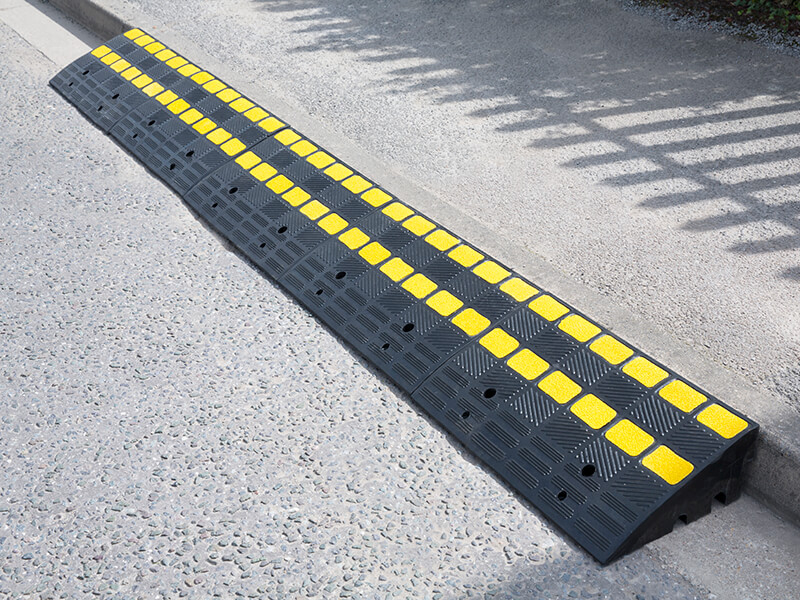Introduction
Kerb ramps are essential for improving accessibility. They allow vehicles and pedestrians to safely navigate uneven and raised surfaces. These ramps are quick to install, and they provide many benefits. For example, a ramp may be needed to allow cage trolleys to access raised paving outside of warehouses and loading areas or for wheelchair users to gain access to a disabled ramp via a step.
In this comprehensive guide, a leading supplier of high-quality kerb ramps for cars explores their different types, their placements and answers common questions regarding their legality and their installation.
Kerb Ramps Benefits
Kerb ramps have many benefits that go beyond their obvious accessibility advantage:
Safety Enhancement
Kerb ramps are a great way to improve the safety of vehicles and pedestrians by providing a smooth transition from one elevation to another. This is particularly important at intersections, where driveways or private paths meet the road. The seamless ramp connecting two sections will also reduce the risk of vehicles suffering suspension damage or tyre wearing when crossing a kerb.
Convenience to Pedestrians
Kerb ramps provide a safer way of accessing kerbs for pedestrians. For example, those with mobility issues, parents pushing strollers or people using wheelchairs or trollies may find it difficult to climb kerbs without assistance.
Promoting Active Transport
Accessible pathways encourage alternative modes of transport, such as bikes and scooters. This promotes a healthier, more sustainable lifestyle in the city.
There are several different types of kerb-ramps, each with their own benefits and drawbacks. The type of kerb-ramp that is best for a specific location depends on the needs of users and the layout.
Different Types of Kerb Ramps
From a fitting perspective, there are three types of kerbs ramps:
Portable Kerb Ramps: These ramps are light and easy to move, making them perfect for temporary uses such as construction sites and events, or in places with limited space. The portable kerb ramps can be folded up or rolled for storage.
Modular Kerb Ramps: These ramps are made of sections that can be joined together to form a ramp any size or length. Modular kerbs are usually made from rubber or concrete and are more durable.
We offers many solutions to connect multiple ramps together to the desired length. We offers a range of modular ramps that can be easily and quickly deployed. They are ideal for running through vehicle traffic zones, including options for HGV accessibility whilst protecting cables and pipes.
Permanent Kerb Ramps: These are ramps that are permanently installed into the ground. They are ideal for areas with high traffic and access requirements which are likely to remain the same. These ramps are made from concrete or heavy-duty rubber that is non-slip and designed to handle heavy traffic. We also supply kerbs in modular form.
FAQs:
Can kerb ramps be legally installed?
In many places it is not just legal, but mandated, to install kerb ramps, both in public and private areas, to meet accessibility standards. There are some exceptions to the rule. For example, it’s illegal to drive up to a driveway that is in front of an establishment without a drop-kerb. You must first obtain permission from your local council, and then commission a contractor approved by the council to complete the work. We recommend that you consult your local council if you are unsure.
What is the cost of building a ramp in UK?
The price of a kerb-ramp in the UK is entirely dependent on its length, material and size. You should check the sections that you will need, and if necessary any end or centre sections. Our sales team is available to help if you require assistance.
We installation team will be more than happy to help you with this process.
How to secure a kerb-ramp?
The type of kerb ramp will determine how it is secured. Concrete ramps that are permanent are usually installed by pouring concrete during construction and letting it set. A heavy-duty rubber kerb is either bolted into place or secured with concrete. It is possible to set up portable and foldable ramps, but you should always check the instructions of the manufacturer to ensure that they are stable and safe.
What ratio is there for a kerb-ramp?
According to accessibility guidelines the ideal ratio of a kerb-ramp is 1:12. The ramp should be 12 inches long for every inch in height. This ratio will ensure a gradual slope, which makes it easier for people with mobility issues to use the ramp.
Are you looking for alternative vehicle safety solutions?
Vehicle Stops: Effective devices for stopping vehicles. They can be installed near walls, fences, or car parks. These high-visibility safety rubber solutions with reflective strips are popularly installed in front electric car charging equipment. They reduce the risk of accidents, bumps and scrapes.
Mirrors for Traffic: Help drivers gain a better understanding of the road by using a variety of mirrors that are suitable for indoor and outdoor use.
Flow Plates and Speed Bump: Select from a variety of modular ranges to reduce traffic speed and calm the flow in high-risk zones such as supermarket parking lots, school zones and residential areas.

